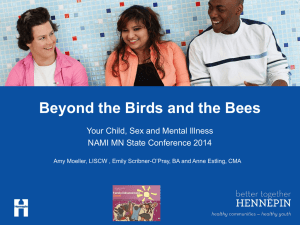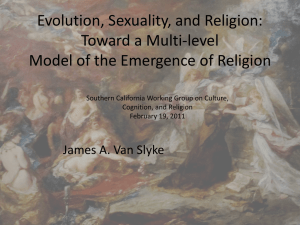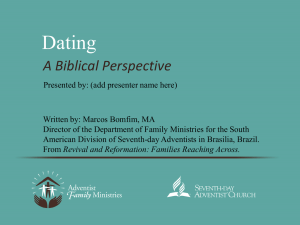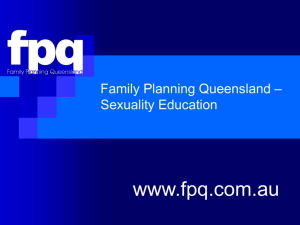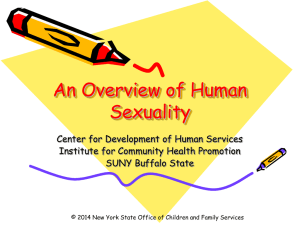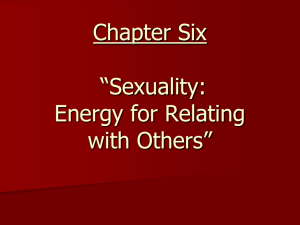Sexuality Education
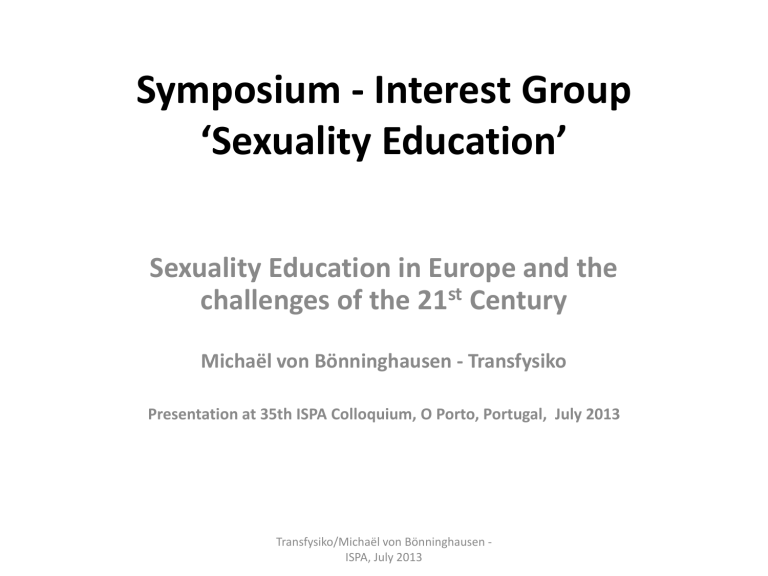
Symposium - Interest Group
‘Sexuality Education’
Sexuality Education in Europe and the challenges of the 21
st
Century
Michaël von Bönninghausen - Transfysiko
Presentation at 35th ISPA Colloquium, O Porto, Portugal, July 2013
Transfysiko/Michaël von Bönninghausen -
ISPA, July 2013
Why Sexuality Education in schools ?
• Globalization and migration of populations with different cultural en religious background.
• Rapid spread of new media like internet, smartphones etc.
• Emerge and spread of HIV/AIDS and STI’s
• Increasing concern about sexual abuse of children and adolescents
• Changing attitudes towards sexuality.
• Changing sexual behaviour among young people.
Transfysiko/Michaël von Bönninghausen -
ISPA, July 2013
Sexuality education in Europe
• Western European countries
Sexual revolution in the 70’s: modern reliable methods of contraception (pill), legalization of abortion, emancipation of women and emancipation LGBT.
Sweden ( 1955), Scandinavian countries (60’s), Gertmany (1968),
Austria (1970), Netherlands and Switzerland (70’s), France and United
Kingdom ( 90’s), Portugal, Spain and Ireland (2003).
• Central and Eastern Europe
Started after the fall of communism 20 to 30 yaers later then Western
European countries. Forerunners: Czech Republic and Estonia.
Slowed down by emerge of conservatism political, cultural and religious.
Transfysiko/Michaël von Bönninghausen -
ISPA, July 2013
Programmes of sexuality education (1)
• ‘Abstinence only’ programmes
Focus primarily or exclusively on abstaining of sexual intercourse before marriage.
Known as ‘how to say no’ or ‘abstinence only’ programmes.
• Comprehensive sexuality education
Attention to ‘safe sex practices’.
Consensual (sexual) relationship and intercourse.
Prevention of pregnancy and STI’s by using contraception and condoms.
Including abstinence as option.
Transfysiko/Michaël von Bönninghausen -
ISPA, July 2013
Programmes of sexuality education (2)
• Holistic sexuality education
Including comprehensive sexuality education but it has a wider perspective.
Sexual development is seen as being part of the personal and sexual growth and development.
Age appropriate and related to the developmental tasks of children and adolescents.
Starting at the age 5 years when children are going to school until the age of 16/18 when adolescents leave school.
Sexuality is seen as a valuable source of personal enrichment.
Transfysiko/Michaël von Bönninghausen -
ISPA, July 2013
Programmes in Europe and the USA
• Positive sexual development – (Europe)
Are personal-growth orientated.
Sexuality developing during adolescence is seen as valuable source of enrichment.
Sexuality is seen as enjoyable and not as a problem or a threat.
• Prevention of risk factors in the sexual development – (USA)
Sexuality is in general more seen as a problem and a threat.
Problem-solving and prevention orientated focussing on abstinence.
Transfysiko/Michaël von Bönninghausen -
ISPA, July 2013
Definition of sexual health – WHO (2006)
• Sexual health is a state of physical, emotional, mental and
social well-being in relation to sexuality; it is not merely the absence of disease, dysfunction or infirmity.
• Sexual health requires a positive and respectful approach to sexuality and sexual relationships, as well as the possibility of having pleasurable and safe sexual experiences, free of coercion, discrimination and violence.
• For sexual health to be attained and maintained, the sexual
rights of all persons must be respected, protected and fulfilled.
Transfysiko/Michaël von Bönninghausen -
ISPA, July 2013
Characteristics of sexuality education
Active participation of youth for example Peer-education.
Interactive exchange between teachers and learners.
Continuous delivering of age-appropriate programs on sexuality education.
Delivering sexuality education in a cross curricular way. Linking it to other sectors like health services and counselling centres.
Paying attention to the context of the learners like cultural and social background, sexual orientation, gender, individual capacities etc.
Close cooperation with parents and the community.
Gender responsive to ensure that different gender needs are addressed.
An important requirement is that an atmosphere of safety and trust should be established by finding rules the group agrees on.
Transfysiko/Michaël von Bönninghausen -
ISPA, July 2013
Sexual rights of the Child
1. To have the highest attainable standard of sexual health.
2. To seek and receive impart information related to sexuality.
3. Sexuality education.
4. Respect for bodily integrity.
5. Choose their partner.
6. Decide to be sexually active or not.
7. Consensual sexual relationships.
8. Consensual marriage.
9. Decide whether or not, and when, to have children.
10. Pursue a satisfying, safe and pleasurable sexual live.
Transfysiko/Michaël von Bönninghausen -
ISPA, July 2013
Outcome of sexuality education (1)
• To contribute to an open social climate that is respectful towards sexuality, various lifestyles, attitudes and values.
• To respect sexual diversity and gender differences and to be aware of sexual identity and gender roles.
• To empower learners to make informed choices and acting responsibly towards oneself and one’s partner.
• To have knowledge about the human body, its development and functions, in particular regarding sexuality.
• To learn to express feelings and needs , to experience sexuality in a pleasurable way and to develop one’s own gender role and sexual identity.
• To have gained appropriate information about physical, cognitive, social, emotional and cultural aspects of sexuality, contraception, sexual coercion and prevention of STI’s and HIV.
Transfysiko/Michaël von Bönninghausen -
ISPA, July 2013
Outcome of sexuality education (2)
• To have the necessary live skills to deal with all aspects of sexuality and relationships.
• To have information about access to counselling and medical services particularly related to sexuality.
• To reflect on sexuality and diverse norms and values with regards to human rights in order to develop one’s own critical attitude.
• To be able to build sexual relationships in which there’s mutual understanding and respect for one another’s needs and boundaries and to have equal relationships. This contributes to the prevention of sexual abuse and violence .
• To be able to communicate about sexuality, emotions and relationships and have the necessary language to do so.
Transfysiko/Michaël von Bönninghausen -
ISPA, July 2013
Challenges in the 21
st
century
• Challenges are to develop programs that
Focus on the positive sexual development of the youth.
Focus on 21 st century educational skills like critical thinking and problem solving, media and ICT literacy, self direction and responsibility.
Stimulate active participation of youth – for example Peer education.
Pay attention from a positive perspective to vulnerable groups like youth with a psychiatric disorder, that are traumatized (sexual abuse), mentally retarded.
Pay attention to different lifestyles, gender differences, sexual diversity and prevention of suicidal thoughts / suicide.
Are science based and have sufficient level of implementation fidelity.
Appropriate for the different countries in Europe and the different situations within the countries.
Transfysiko/Michaël von Bönninghausen -
ISPA, July 2013
European projects and activities
• Pestalozzi Programme of the Council of Europe
Modules series ‘Sex/sexuality – Personal development for the prevention of discrimination and violence’ (2013 – 2014).
• Directorate Human Rights and Rule of Law, Council of Europe
Building a Europe for and with children - ONE in FIVE Campaign to stop sexual violence against children (2010 – 2015).
Council of Europe - Convention on the protection of children against sexual exploitation and sexual abuse (Lanzarote, 2007).
Council of Europe - Convention on preventing and combating violence against women and domestic violence (Istanbul, 2011).
• European Federation of Sexology ( region of WAS)
Campaign on sexual rights ‘To achieve sexual health, picture yourself owning your sexual rights’ (2013).
Transfysiko/Michaël von Bönninghausen -
ISPA, July 2013
Contact and information
Michaël von Bönninghausen - Transfysiko info@transfysiko.nl
-
Chair interest group ‘Sexuality Education’ - ISPA.
- Facilitator Pestalozzi Programme – Module series ‘Sexuality
Education’ 2013 – 2014.
- Chair interest group ‘Youth and Sexuality’ - Netherlands
Institute of Psychologists.
Transfysiko/Michaël von Bönninghausen -
ISPA, July 2013



